My Daily Journal from England - Final Thoughts
I’m fresh off one of the greatest golf tours in my life… the Heath & Links Tour of England. For those who tracked my daily journal entries, hopefully you gained some sense of what we were exposed to over those ten days. And for those who did not – or simply want to gain a general perspective of the experience, this final journal entry will hopefully prove inspirational.
The Tour
It’s not Scotland and it’s not Ireland, but there are some pieces of each with England’s own unique touches as well. The golf experience was certainly diverse… two heathland courses (Sunningdale and Berkshire) followed by two links courses (Royal St. George’s and Royal Cinque Ports), then back to the heathlands (Walton Heath) and on to links again (St. Enodoc, Royal North Devon and Burnham & Berrow) and a strong heathlands finish (Swinley Forest, Woking (only 5 holes) and St. George’s Hill). That’s 185 golf holes in ten days!
So…Heath or Links?
Both are so uniquely good and yet so different. England is blessed to feature the best of both. My impression of the heathland courses begins with great beauty…a contrast of maintained turf against the backdrop of pines, heather and rhododendrons… colors and textures… a wonderful palate for an architect to work with to define strategies and demark margins of play. The terrain is ideal… rolling contours (sometimes dramatic) and generally sandy, loamy soils that are the most ideal for golf. Heather is rough stuff… you can only hope to wedge out and move along. Some courses have allowed the heather to encroach too far into play, in my opinion… negating the architect’s original design intentions, options and strategies. Golfers there seem way more tolerant of the impacts of heather than I would have imagined. It wouldn’t go over well here, I can promise you! Harry Colt, Herbert Fowler and Willie Park, Jr. dominated the heathland scene.
 Sunningdale - king of the heather
Sunningdale - king of the heather
Links golf is a brand that I was certainly more familiar with, having traveled a number of times to Scotland and Ireland. Links golf is the purest form of golf there is… there is a storied history to its derivation. Without the linksland, we wouldn’t have golf at all… and I suppose that’s why it’s my favorite brand of golf to play. I enjoy the firm, running surfaces, the odd contours and randomness. Links golf invites quirkiness and deviation from norms… like the creativity that children employ in the games they make up. There’s nothing quite like it – and if you don’t appreciate links golf, then you probably don’t quite understand what the game is all about. To my surprise, I found that England (like Scotland and Ireland) is home to some of the finest links courses in the world. Names like Colt and Fowler resurfaced on the links, along with Old Tom Morris and James Braid.
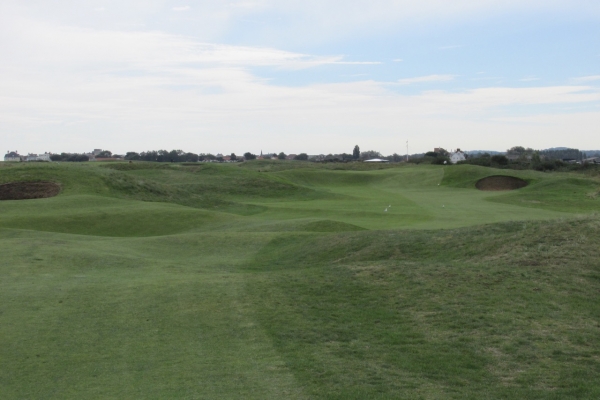 The raw, natural links at Royal Cinque Ports (Deal)
The raw, natural links at Royal Cinque Ports (Deal)
The Works of Colt & Fowler?
I won’t beat around the bush regarding Harry Colt… I think he may be the best there ever was… period. He takes you on a journey… exposes you to so much variety, but all within the context of the varied terrain and setting. Colt baits players with width, like a disguise. His use of angles on a landscape is masterful…as is his understanding of depth, deception, scale and proportion… with bunkering, hummocks, positioning of fairways and contouring complementary greens. Maybe he picked up a few things from MacKenzie? And certainly these qualities are more artistic classifications… but they are vitally important for an architect to possess such an ability to very simplistically employ them as the test of golf is created. When it’s all done right, you know it – and Harry Colt got it.
 Harry Colt at his finest (also his least bad) - Swinley Forest
Harry Colt at his finest (also his least bad) - Swinley Forest
And what of Herbert Fowler? Maybe he wasn’t quite the artist that Colt was… but he was darned skilled at creating a proper test of golf. His eccentric efforts at The Berkshire were exhilarating to see… with such playful greens and an arrangement of holes unlike any other I’ve seen… six 3’s, six 4’s and six 5’s on the Red Course. Then at Royal North Devon he tweaked Old Tom Morris’ work employing a ‘less is more’ approach… solid, but also very simple. Maybe his finest work, Walton Heath, is a testament to his artistic flare and ability to balance strategic features on an otherwise subtle landscape - absolutely beautiful work.
 Herbert Fowler's grandest effort - Walton Heath
Herbert Fowler's grandest effort - Walton Heath
Golf in England
I hope I don’t go too far here… but I was really refreshed by what I saw on the courses during this trip (not that it was a great surprise, given all my other trips to the British Isles), but again, I was reminded. Golf is social… golf is NOT exclusive…golf is exercise… and golf can be shared with one’s dog! Dogs are everywhere and welcomed - even at the poshest clubs! The game is played differently there than in the US… they play quickly… they play matches. Four-balls are rarely allowed, two-balls and three-balls are normal and preferred. Golfers don’t tend to play for scores… and they don’t obsess about handicaps. They play for the brisk walk, the companionship and for the gamesmanship of a friendly match… and if takes more than three hours, then it’s probably not worth doing. They also appreciate good architecture… they realize that the game is a test of humility and they're very content with that. The English don’t have an air of golf entitlement – they just play. Pinch me, England, I’m in love!
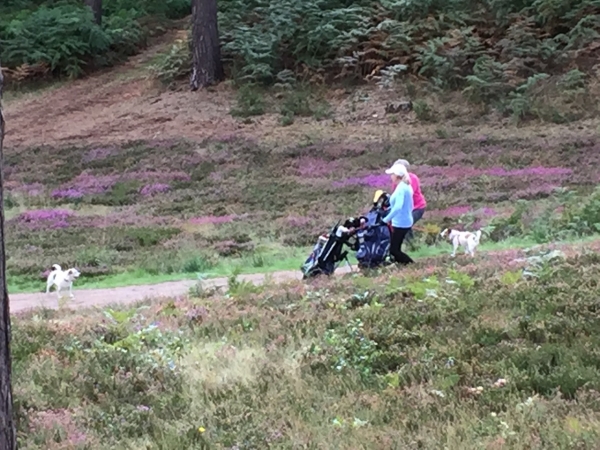 Dogs love golf too - like these guys at The Berkshire
Dogs love golf too - like these guys at The Berkshire
Par is Par
If you think that an arrangement of 36-36-72 is the rule of thumb, then plan to be disappointed in England. Par is whatever the architects happened to feel fit the ground the best. In ten days, I played courses with pars of 68, 69, 70, 71 and 72. One of the 72’s had six each of 3’s, 4’s and 5’s. The par 68 was Swinley Forest at just over 6200 yards… and that included 8 par fours over 400 yards! Swinley may be one of the best I’ve ever seen. I guess my take here is… don’t get tied up in knots over what you think par should be or that something isn’t valid because of a break from the norm. I enjoyed each of the courses just the same… par was irrelevant. Most of the time, I didn’t even realize the overall par until the round was nearing completion. I suppose I was just having too much fun!
Short Holes
We can talk about par-3’s here and maybe a few par-4’s… short holes...and they’re the absolute soul of the game that I enjoyed for ten days. Like with the matter of par, let’s again push through some preconceived notions about par-3’s. On one course, I played six of them. On another course, the round started with one. On another, the round ended with one. A par three can be the second hole… and on several courses, a par-3 was the tenth hole. Much to my surprise, we never played consecutive 3’s… but we already know that can work as well (Cypress Point, Oitavos Dunes, Newport National, etc.). The short holes provide more than just links between longer holes, they’re strategically “fitted” into the sequence where they can be inspirational to the experience and provide great variety to one’s round. I saw some damn good one’s too…the 10th at The Berkshire, the 8th at St. George’s Hill, the 4th at Swinley Forest, the 6th and 16th at Royal St. George’s, the 17th at St. Enodoc…they’re all real beauties.
 As short holes go, the 10th at Berkshire Red is a brute And the short 4’s… From an architect’s perspective, I feel strongly about having at least one, dynamic, strategic and potentially reachable 4-par in a round – I think that helps make the golf course and experience complete – and fun! Such a hole should entice bold play and reward the best shots handsomely… but always with the chance of peril. Maybe the best I saw was the 4th at St. George’s Hill – as enticing as I’ve seen. Others include the 6th at Royal Cinque Ports, the 3rd at Walton Heath, the 11th at Swinley Forest, the 12th at Berkshire Red and the 4th at St. Enodoc.
As short holes go, the 10th at Berkshire Red is a brute And the short 4’s… From an architect’s perspective, I feel strongly about having at least one, dynamic, strategic and potentially reachable 4-par in a round – I think that helps make the golf course and experience complete – and fun! Such a hole should entice bold play and reward the best shots handsomely… but always with the chance of peril. Maybe the best I saw was the 4th at St. George’s Hill – as enticing as I’ve seen. Others include the 6th at Royal Cinque Ports, the 3rd at Walton Heath, the 11th at Swinley Forest, the 12th at Berkshire Red and the 4th at St. Enodoc.
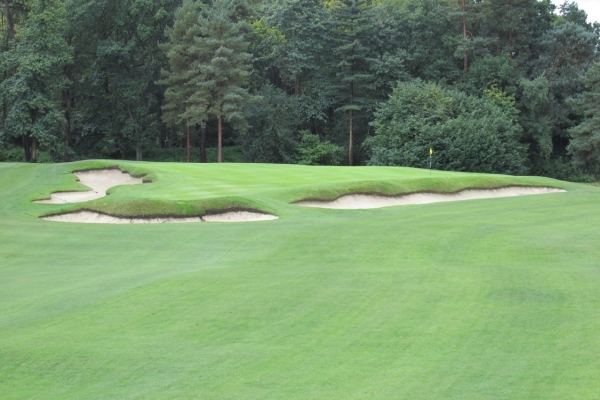 St. George's Hill's 4th - one of the most enticing "take dead aim" short fours in existence
St. George's Hill's 4th - one of the most enticing "take dead aim" short fours in existence
Misc. Design Attributes
We saw amazing green contours, especially at Royal Cinque Ports and Royal St. George’s, among others… varied with boldness to repel or collect, dramatic segmentation and pocketing followed by subtle rippling. With some, maybe the credit goes to Nature… while others were obvious at the masterful hand of man.
Hazards on these courses are… well… less inviting than what were accustomed to. Deep, sod-walled pits, heather laced embankments and even a few fortified ramparts. The one thing about hazards… mainly bunkers - is that when they’re properly placed, they can make a standard hole into one of the most memorable, and devious, that you’ll ever play. Take the 6th “Himalayas” at St. Enodoc… and the 4th at Royal St. George’s (some refer to it also as “Himalayas”)… and what about the 4th “Cape Bunker” at Royal North Devon? How about the sloped bank on the 10th at the Berkshire?... and the steep, shaved slope fronting the green on the 6th at Royal Cinque Ports? The strategic placement of bunkers and features was also prevalent… like the 4th hole at Woking and all the subtle placements from Colt at Swinley Forest and Sunningdale as well as Fowler’s randomness at Walton Heath.
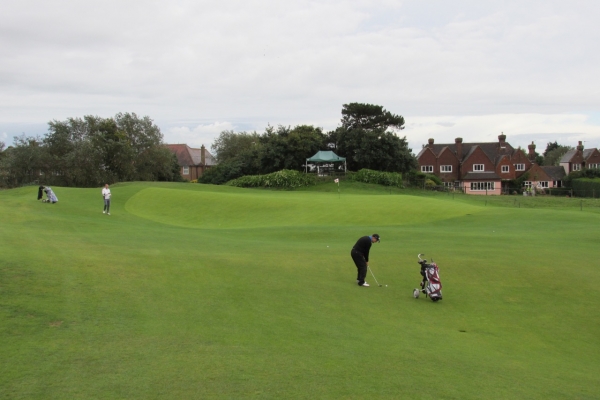 Bold and beautiful contours on the 4th green at Royal St. George's (Sandwich)
Bold and beautiful contours on the 4th green at Royal St. George's (Sandwich) As hazards go, the “Himalayas” at St. Enodoc's par four 6th may take the cake
As hazards go, the “Himalayas” at St. Enodoc's par four 6th may take the cake
One thing that really pleased me and captured me at the same time was the use of angled fairways. Sounds simple, doesn’t it? Really, it is… but rarely done well. All of the courses I saw in England had more than a few holes where the tee placement worked with an angled fairway to tempt a player… and what looks to be an enormously wide target, in fact, requires commitment and execution of a very precise tee shot. All the architect requires is width… the space to use the terrain as he wishes. But the result is a shot with options… and options lead to a more enjoyable golf experience. Three cheers for angled fairways!
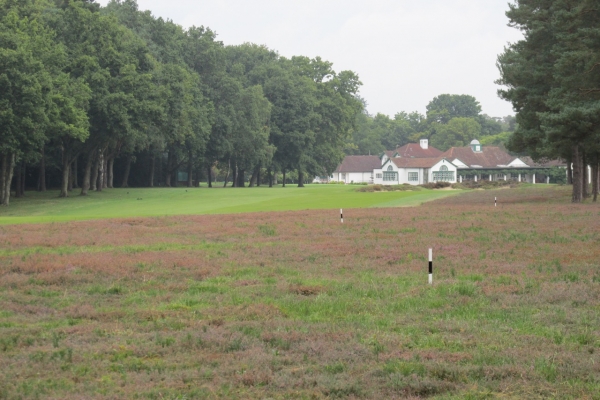 Strategic, angled fairways abound, like this one at Woking's beautiful 14th
Strategic, angled fairways abound, like this one at Woking's beautiful 14th
Final Thoughts
Of all the architecture I witnessed in England, what struck me most about the holes was the simplicity in which they were devised… simple positioning, simple development of greens, simple alignment of fairways and simple use/placement of innate features. The courses were not complicated in their design, in fact far from complex. They were very simply fitted on a proper landscape for the intended use and very strategically developed to provide the best golf experience. That’s great architecture… and that’s why I had longed to make this trip.
 Royal North Devon (Westward Ho!) - Golf in its purest and simplest form
Royal North Devon (Westward Ho!) - Golf in its purest and simplest form
I’m really blessed to have now witnessed some of the best architecture England has to offer, from the hands of Harry Colt, Herbert Fowler, Willie Park, Jr., James Braid, Tom Dunn, and Laidlaw Purves, among others - really great stuff! I’m not going to rank the courses I saw… and I don’t have a scale bearing my name to push on anyone to help them assess their experiences. See them as you wish! If nothing else, I hope my journal inspires others to get out and see these great courses to appreciate what they’re all about. We all share a commonality in that we truly love golf and we owe it to ourselves to examine how the game originated and how it has evolved!
My time in England was epic… the brand of golf was refreshing and pure, the courses were raw and playful…beautiful and engaging. Today, I’m home, inspired as ever to create even more enjoyable golf encounters with my clients. Amazing trips like this one pave the way for even more creativity and a fresh outlook on the game.
Tags
A.W. Tillinghast , Alister Mackenzie , Architectural Study Tour , ASGCA , Bunkers , Burnham & Berrow , Classic Courses , Course Design , Course Rankings , Design Elements , Donald Ross , Enjoyable Golf , European Courses , Golf & Travel , Golf and the Landscape , Golf Course Architecture , Golf Course Improvements , Golf Course Maintenance , Golfing Destinations , H.S. Colt , Hazards in golf , Heather and gorse , Heathland Golf , Herbert Fowler , James Braid , Links Golf , Newport National Golf Club , Oitavos Dunes , Old Elm Club , Royal Cinque Ports , Royal North Devon , Royal St. Georges , Short Courses , Short Par Fours , Social Side of Golf , Speed of Play , St. Enodoc , Strategic golf , Strategic Options , Sunningdale , Surrey , Swinley Forest , The Berkshire , Tom Dunn , Tom Simpson , Walton Heath , Why Golf is Fun , Width and golf , Willie Park, Jr. ,

Comments